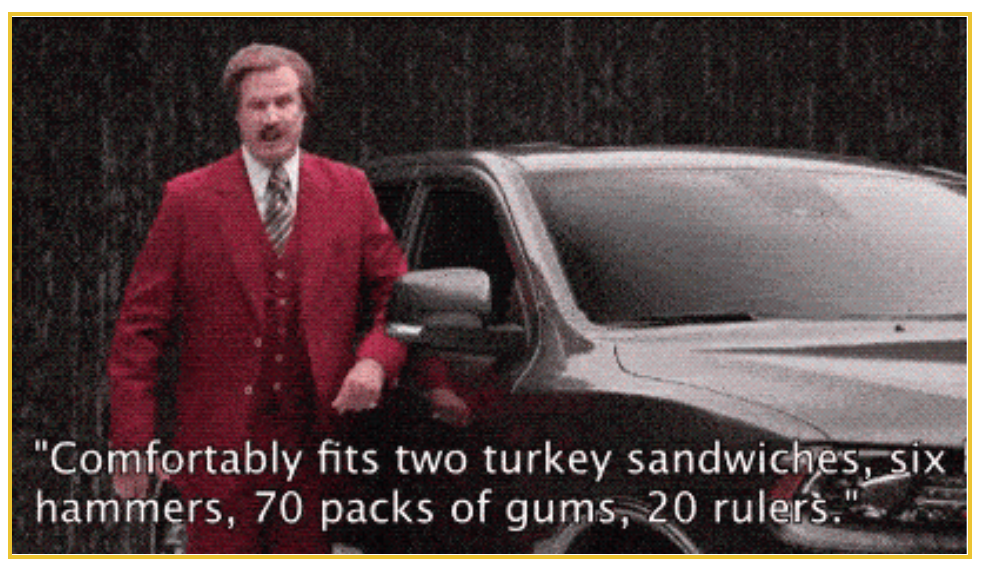Do you know what some of the most successful brands on Facebook have in common? Facebook sales funnel.
Imagine this, you are chilling out with your friends on a nice Sunday afternoon and suddenly a salesperson swoops in out of nowhere selling an exclusive chest-press machine to you.
Will you be interested in buying it? Not unless you are in real need of a chest-press machine – but what are the odds of that?
The same goes for Facebook. Most users do not log in to Facebook to search for products or make purchases. Instead, they want to check on their friends, see what is new is happening in their community, and update their statuses.
Look at this graph by Statista showing where users spend most of their time on Facebook:

The above graph should not come as a surprise to many. Facebook is a social networking site and people on the network are communicating their values by liking and commenting on various posts.
But this doesn’t mean Facebook isn’t worth the investment.
Over 3 million businesses use Facebook to actively advertise and reach their target audience on the platform. With its laser-focused targeting capabilities and the potential to reach one-third (yes, ONE-THIRD) of the total world population, it is no more than a valuable asset to businesses.
The only problem lies in how most marketers approach their audiences by being overhasty to sell their products.
As mentioned above, Facebook is about being social and not broadcasting your latest offer or pitching your latest deal.
You don’t have to go all on in one go, like:

Seriously, take a breath.
We aren’t celebrities. For most of us, the advertising process requires a fine balance between providing our audience with value and promoting our products, in order to ensure that people don’t turn away.
But how? By developing your own Facebook sales funnel!
What is Facebook Sales Funnel?
A Facebook sales funnel is a map of the journey a user takes to make a purchase.
Think about this:
- People engage with your Facebook posts, which makes the first step of your sales funnel.
- They decide to visit your website, which takes them to the second stage.
- The third stage is when they interact with value-enriched content or product descriptions on your website. This helps them in the decision-making process.
- After heavy research and comparison, the visitor finally decides to purchase from you – this means that they’ve successfully entered the final stage of the funnel.
These are different touchpoints your prospect goes through when interacting with your business. Fully understanding a funnel will help you be able to fill the gaps or remove the blocks from the stages your prospect drops out from.
A Facebook sales funnel is a much more robust marketing process than just simply setting out a budget and the ad type and waiting for all the conversions to magically happen. Below we’ll explain in detail how it actually works.
How Does Facebook Sales Funnel Work?
Imagine a funnel. What comes to your mind?
A conical utensil that narrows down at the apex, right? A sales funnel, similarly, narrows down as the user goes through it. To understand this, you need to be familiar with each stage of a sales funnel first.
Stage 1: Brand Awareness
How will the user purchase from you if they don’t even know about your existence?
That is why a funnel begins with customers ‘awareness’ about your brand – and this is also where Facebook transcends every other social media platform.
If the odds are in your favor, the customer may immediately buy from you at the first stage only. They’ve done their research and know that what you are offering is in their interest and is also at a fair price.
You can say the awareness stage is more of a dating period where you persuade your prospect to get to know you better and engage with you in order to develop a relationship.
Stage 2: Generate Interest
The consumer has entered the interest stage of the funnel.
They are doing their research, comparison, and thinking over their options. This is the right time to pounce on your great content that helps them but also doesn’t directly sell to them.
Remember that this is still the initial stage, and if you try to push your product or service too much, your prospects may turn away. The goal of providing them with your content is to establish your expertise and help consumers make the right choice.
Stage 3: Decision
The decision stage of the sales funnel is where the customer has decided if they want to do business with you or not.
This is where you will swoop in some offers. This can include, free shipping, a discount code, or any reward. Whatever it is, make it so enticing that your lead can’t wait to take advantage of it.
Stage 4: Action
Your customer enters the final stage of the funnel when he finally purchased your product or service. But this isn’t the stage where the funnel ends. You do not want your new customers to close the deal and disappear forever.
Rather you should check consistently with these customers either via email, or social media. Express gratitude for the purchase, send feedback forms, and make yourself available for any queries.
To understand it better here is an example of an effective Facebook sales funnel
 Imagine that you own a travel agency that wants to sell their holiday packages for the season. Your target audience is males and females between the ages group of 20-65.
Imagine that you own a travel agency that wants to sell their holiday packages for the season. Your target audience is males and females between the ages group of 20-65.
You attracted that audience to your page running an amazing Facebook ad. Now, you ask them to like the page for exclusive updates about the package.
This has successfully turned your prospects into leads. Now they are slowly moving through the funnel.
Over the weeks, you’re sharing fun and engaging content on your Facebook page. This can be a blog post about the best places to eat & drink at the holiday destinations or a video sharing the top tips one needs to know before traveling to that place.
You can end up all those pieces by suggesting an additional product on top of this standard package like a private telescope viewing session – and BAM! You’re selling your holiday package at the snap of your fingers. You turned your leads into customers.
You clearly understand that this isn’t the end of the funnel. You know that your loyal customers can be your best promoters.
When they sign up for your holiday package, you ask their email addresses so you can send out surveys or loyalty programs to keep your business in your customer’s minds.
Just like that, you’ve passed every stage of a customer’s journey:
- You created awareness about your package and led prospects to your page through the Facebook ad.
- You generated interest among your audience by asking them to like the page for more updates.
- You constantly shared valuable content to help your audience decide whether they want to make a purchase or not.
- You offered something that prompted them to take the desired action i.e., finally purchasing your package.
Now that you’ve understood how a Facebook sales funnel works, it is time to create one for your business.
How To Create A Facebook Sales Funnel
You’re completely pumped now and cannot wait to create a sales funnel for your Facebook page and we totally understand that.
So, without eating much of your time, here we list down five easy steps to create your Facebook sales funnel today:
Step 1: Promote to your existing audience first
There are two types of audiences you want to promote your business to:
- Warm audience: The audience is basically people who’ve already visited your website before or have been exposed to your brand in some other way. You don’t need to introduce yourself to them as they are already familiar with your brand.
- Cold audience: This group of people is created as a “lookalike audience” which means they are similar to your existing customers but have no idea about your brand.
Since your warm audience should be your primary target in promoting your content first. Since they already recognize you, you will not have to introduce yourself to them. Pay attention to what type of content they engage with the most and determine what content is leading to more purchases.
When you understand what performs best with your warm audience, you can share that with your cold audience as well.
Step 2: Give away free content
As we mentioned earlier, directly selling on the initial touchpoints may turn prospects away. The goal is to first introduce your brand or product than just asking them to sign-up for your email list right away.
Your first interaction with your audience can be a peek into your new upcoming project, a small photo contest, or a giveaway. For example, Warby Parker, an American online retailer of prescription glasses and sunglasses, promoted their brand with a quiz before directing their audience to a sales offer.
Step 3: Retarget those who interacted with your Facebook ad
A large chunk of your audience interacted with your Facebook ad – but guess what, they are still unsure of buying your product. Obviously, it doesn’t work like that.
According to studies, a prospect needs to “hear” the advertiser’s message at least 7 times before they’ll take action to buy that product or service.
Now is the time to utilize the power of Facebook ads and target people based on their engagement with your ad. These can be people who opened your link but exited without taking any action or the people who watched at least three seconds of the video you shared.
We’d recommend that you still don’t try to directly sell to your audience here as well. Instead, go one step further and introduce an offer like access to a free eBook, or interviews with industry experts.
Step 4: Retarget again – but this time, SELL!
Now you know the audience who is genuinely interested in your business.
Your audience is interacting with your business or the fourth time now. This is the perfect time to direct users to your landing page in order to make a purchase – but don’t end it here.
Chances are most users who land on the page are still skeptical to sign-up. This is where you need to understand the beauty that is Facebook Pixel.
Facebook Pixel helps you retarget people who visited your landing page but didn’t take you up on your offer.
Step 5: Retarget to encourage purchase
We cannot stress this tip enough: Don’t think your job is over just because your customer has checked out. Remember that, it is always easier to continue sales with the old customers before pitching in for the new ones.
In fact, the probability of selling something to an existing customer is 60 to 70 percent whereas selling to a new prospect is 5 to 20 percent. (Source: eConsultancy)
Set up retargeting campaigns to show recent customer recommendations based on what they’ve already purchased or show products that they might be interested in. Customer retention shouldn’t be overlooked if your goal is to increase sales and revenue.
Conclusion: Create Facebook sales funnel for your business
Phew! Looks like we finally made it to the end of it. We’ve covered a lot and your head must be birling consuming all that information at once.
To quickly conclude everything, we’ll say that Facebook has enormous potential to bring exposure to your brand. To do this effectively, you need to have a Facebook sales funnel in place.
Funnels are a great way to take your cold audience and turn them into loyal customers. In many cases, you can have multiple funnels established to appeal to different segments of your audience.
Don’t be disappointed if you fail to get the expected results out of your funnel. Keep tweaking and adjusting until you build a truly successful Facebook sales funnel.
Did we miss anything? What are your thoughts about the Facebook sales funnel? Let us know by reaching out to us below.

Aayush Narang is the founder of Spark Eighteen Lifestyle Pvt. Ltd a Digital Marketing Agency in Delhi. He is a Startup Evangelist. Entrepreneur. Business and Tech Enthusiast.

